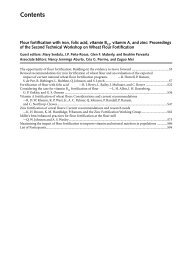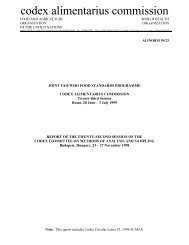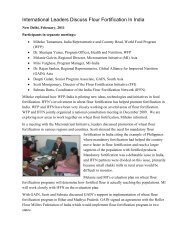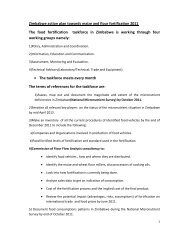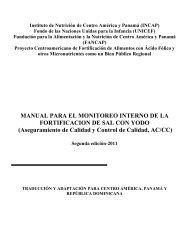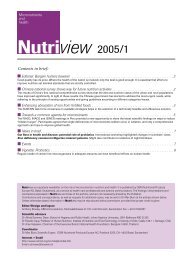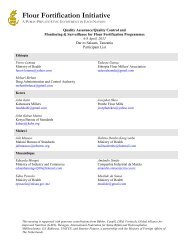St. Vincent and Grenadines
St. Vincent and Grenadines
St. Vincent and Grenadines
Create successful ePaper yourself
Turn your PDF publications into a flip-book with our unique Google optimized e-Paper software.
SVGNS 13: 2002<br />
0.2 FOREWORD<br />
0.2.1 This st<strong>and</strong>ard has been prepared through the Caribbean Common Market <strong>St</strong><strong>and</strong>ards<br />
Council (CCMSC)* to set a level of quality for wheat flour manufactured <strong>and</strong> traded<br />
within the Caribbean Community. It was accepted by the CCMSC in June 1992, after<br />
the consideration of comments received on a draft circulated between November 1990<br />
<strong>and</strong> June 1992, <strong>and</strong> approved by Council of Ministers in June 1992 for use as a<br />
m<strong>and</strong>atory st<strong>and</strong>ard.<br />
0.2.2 Wheat flour that conforms to this st<strong>and</strong>ard <strong>and</strong> which is made under an approved system<br />
of quality assurance may be identified by the Caricom <strong>St</strong><strong>and</strong>ard Mark, which is<br />
administered by CCMSC. This programme is supported by the Caricom Export<br />
Development Project.<br />
0.2.3 This st<strong>and</strong>ard sets out the requirements for wheat flour, <strong>and</strong> describes the methods of<br />
sampling <strong>and</strong> testing that should be used. Wheat flour is now manufactured in several<br />
competing with imports from other countries. As wheat flour is an important nutritional<br />
input in domestic cookery, <strong>and</strong> in industrial or commercial baking, an agreed <strong>and</strong><br />
acceptable level of identity, purity, quality, acceptability, <strong>and</strong> nutrient value is desirable<br />
so that flour from the regional sources can move freely within the Community.<br />
0.2.4 In preparing this st<strong>and</strong>ard, guidance was derived from the following:<br />
(a) Codex <strong>St</strong><strong>and</strong>ard for Wheat Flour (Worldwide <strong>St</strong><strong>and</strong>ard), CODEX STAN 152-<br />
1985, FAO/WHO Codex Alimentarius Commission, Rome, Italy;<br />
(b)<br />
<strong>St</strong><strong>and</strong>ard for Flours, Wheaten, CGSB 32-GP-5M, (1978), Canadian General<br />
<strong>St</strong><strong>and</strong>ards Boards, Ottawa, Canada;<br />
(c) Food <strong>and</strong> Drugs Regulations, Canada, B 13.001-002, dated 9 March 1989;<br />
(d) Food <strong>and</strong> Drugs Regulations, Trinidad <strong>and</strong> Tobago, Division 12, 1980.<br />
0.2.5 This st<strong>and</strong>ard will be reviewed, <strong>and</strong> may be revised from time to time to allow for<br />
changes in manufacturing technology or consumer preferences in the Caribbean<br />
Community.<br />
0.2.5 In view of recent decisions in the FAO/WHO Codex Alimentarius/World Food <strong>St</strong><strong>and</strong>ards<br />
Programme, the use of potassium bromate as a food additive in wheat flour is not<br />
permitted by this st<strong>and</strong>ard.<br />
Note*: The CCMSC has been replaced by the CARICOM Regional Organization for<br />
<strong>St</strong><strong>and</strong>ards <strong>and</strong> Quality (CROSQ) as of June 2002.<br />
5




